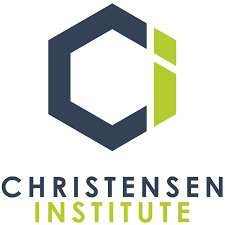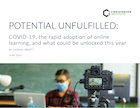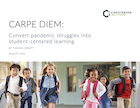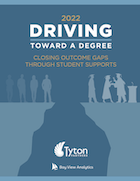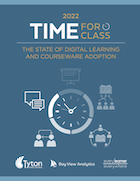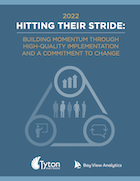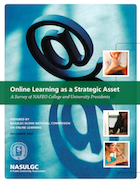Partners
In addition to conducting and releasing our reports, Bay View Analytics also partners with other respected research organizations. Bay View Analytics’ role differs from project to project, but typically includes sampling design, questionnaire design and implementation, data collection, data processing, and analysis.
Clayton Christensen Institute
The Christensen Institute is partnering with Bay View Analytics to conduct a series of nationally representative surveys to learn from the unparalleled mass adoption of online learning. Conducted during the 2020-2021 and 2021-2022 school years, this research documents the programs, technologies, and instructional practices schools and educators turn to as they grapple with the effects of COVID-19. The aim is to learn how educators use online learning, and whether online learning leads to the benefits we have long documented in our blended learning research.
A revealing reality: Spring 2022 survey of teachers and administrators
As schools reopened in fall of 2021, many education leaders and stakeholders predicted that most online learning would fall away, and teachers and students would begin to recover from an unprecedented event. But new data from ongoing, nationally-representative surveys of hundreds of teachers and administrators have uncovered fascinating insights into what’s actually happening in classrooms across the country today, how it compares to COVID-era schooling, and how teachers are currently faring.
Download factsheets:
- How are teachers blending and personalizing learning post-pandemic?
- Which instructional resources do educators rely on?
- How have pandemic shifts affected students from diverse backgrounds?
- What programs have school systems created to support their students?
- How are teachers faring in the wake of the pandemic?
Download factsheets: Reaching toward Recovery
Bay View Analytics and its partner, the Clayton Christensen Institute, have published Reaching toward Recovery. This latest report of K-12 teachers and administrators reveals that while schools are back in-person, things are far from normal. The factsheets are based on the newest in a series of national surveys conducted in October 2021 of 1,074 respondents including teachers and administrators. Overall, the results show that schools are starting to rebound from the impact of the pandemic, with 96% of classes returning to in-person instruction compared to 34% in Spring 2021.
Download report: Potential Unfulfilled: COVID-19, the rapid adoption of online learning, and what could be unlocked this year
After the COVID-19 pandemic forced school buildings to close, online learning became a lifeline for K–12 education. I t let schools carry on in "the cloud" when they couldn't meet in person. But online learning's potential benefits for K–12 go well beyond providing stop-gap solutions during school closures. It offers an opportunity to transform school instruction to better serve the needs of all students.
Download report: Carpe Diem: Convert pandemic struggles into student-centered learning
Bay View Analytics is proud to have partnered with the Clayton Christensen Institute on a groundbreaking study, Carpe Diem: Convert pandemic struggles into student-centered learning . The report details how the COVID-19 pandemic is changing K-12 education, and how the lessons learned from the pandemic response can drive a continuing transition.
Harnessing data from over a thousand teachers and administrators across the US, this report details which remote-learning models and practices did and didn’t work, and why, during the 2020-21 school year. This first-of-its-kind study reveals the range of options employed by teachers and districts during the pandemic. The results show that:- Most teachers employed multiple learning models during the year — sometimes simultaneously.
- Of those teachers who provided in-person and remote education (hybrid), most reported utilizing both methods at the same time.
- Most instruction was single-paced and synchronous, but some hybrid models offered more flexibility.
- Learning management systems are now mainstream, and tools for creating online lessons gained new ground.
- A third of districts intend to offer a full-time virtual school post-pandemic.
Tyton Partners
Bay View Analytics partners with Tyton Partners on three large-scale, multi-year projects supported by the Bill & Melinda Gates Foundation.
Driving Toward a Degree 2022: Closing Outcome Gaps Through Student Supports
In this year’s research, we designed a methodology to measure progress towards equitable academic outcomes by race and ethnicity, represented by data on how the needs of Black, Latinx, Indigenous (BLI) groups, and students with financial needs differ from those of White students. The data also reflects how the scaled implementation of certain advising practices and technologies plays a role in closing gaps in graduation rates by race and ethnicity.
Driving Toward a Degree 2022: Closing Outcome Gaps Through Student Supports
Driving Toward a Degree 2021: Caseload, Coordination, Student Engagement, and Equity
This year's research examines persistent barriers to improving advising in higher education, and includes over 2,800 respondents, representing over 1,300 unique institutions.
Time for Class 2022: The State of Digital Learning and Courseware Adoption
Since 2014, Tyton Partners has monitored the dynamics of the higher education instructional materials and digital learning market to understand the needs of instructors, institutions, and students and to monitor how suppliers are evolving to meet those needs. This 2022 summary provides an updated view of how the pandemic has altered the landscape of teaching, learning, and course materials in higher education.
This report examines how faculty and institutional leaders are using instructional materials to implement teaching practices that can improve student learning and outcomes, especially for students historically underserved by higher education. This report focuses on introductory courses, including gateway courses, which are a “major accelerant of the DFWI rate1 and serve as a significant barrier to long-term college completion and success.”
Time for Class 2022: The State of Digital Learning and Courseware Adoption
Time for Class 2021: The State of Digital Learning and Courseware Adoption
The 2021 summary provides an updated view of how the pandemic has altered the teaching, learning, and course materials landscape in higher education. Informing this research are survey responses from over 1,000 administrators and 3,000 faculty at 1,600 unique post-secondary institutions, and interviews with more than 20 digital learning suppliers.
Time for Class: The State of Digital Learning and Courseware Adoption
Hitting Their Stride 2022: Building Momentum Through High-Quality Implementation and a Commitment to Change
The developmental education reform movement is at a crossroads. While significant shifts in institutional and state policy have worked to dismantle the prior problematic approaches to developmental education, aggregate survey data from the past three years shows little change in self-reported awareness and adoption of key elements of the reform movement. Additionally, the fallout from the COVID-19 pandemic remains a concern for numerous stakeholders in the higher education ecosystem. Enrollment rates, particularly among minority populations and at two-year institutions, continue to decline, and budgetary concerns linger for many institutions, which could negatively impact the developmental education reform movement in the long term.
Hitting Their Stride 2021: Equity, Outcomes, and the Impact of COVID
Results from the 2021 Hitting Their Stride survey add to the understanding of COVID’s impact, by indicating that early progress at institutions serving more racially diverse student bodies was slightly more likely to have slowed due to the pandemic.
Hitting Their Stride: Equity, Outcomes, and the Impact of COVID
NASULGC-Sloan National Commission on Online Learning
The National Association of State Universities and Land-Grant Colleges (NASULGC, A Public University Association), in cooperation with the Alfred P. Sloan Foundation, appointed the NASULGC-Sloan National Commission on Online Learning. This president-led commission is intended to assist and challenge college and university leadership to increasingly view online learning as a strategic tool to achieve broad institutional goals which, in turn, should lead to substantial benefits for today's post-secondary learners.
A critical part of this investigation was the examination of experiences and attitudes of the Presidents and Chancellors of these institutions. Bay View Analytics designed and conducted these studies under their previous name of the Babson Survey Research Group.
Online Learning as a Strategic Asset: A Survey of Presidents and Chancellors
National Association of State Universities and Land-Grant Colleges
Presidents and chancellors are assuming an increasingly visible and integral role in the integration of online education into the functions and missions of their institutions. This national commission was appointed, in cooperation with NASULGC, to better understand the knowledge base and experience of these institutional leaders relative to the strategic use of online learning. The initial effort of the Commission was to survey presidents and chancellors of NASULGC institutions to better understand their views and experiences relative to online learning, and specifically to explore the role of online learning in their strategic thinking. Respondents were also surveyed to determine what they saw as barriers to their strategic use of online education and what role NASULGC might play in the incorporation of online learning into their institutions' strategic planning.
Survey responses, when sorted by the importance that the institution places on online learning as “critical to the long-term strategy of the institution,” show several notable trends. Not surprisingly, institutions that include online learning in their strategic plans were comparatively more likely than their peers to value both the improved student access and recruitment potential that online can offer, as well as the potential pedagogical improvements and increased rates of retention and degree completion. In addition, these campuses indicate a greater recognition of online learning’s potential in strategic partnerships, academic continuity in disaster situations, alumni outreach, and as a tool for faculty recruitment and retention.
A Survey of NAFEO College and University Presidents
National Association for Equal Opportunity in Higher Education
The NASULGC-Sloan National Commission on Online Learning has partnered with the National Association for Equal Opportunity in Higher Education (NAFEO) to gauge the perspectives and experiences of the leaders of Historically Black Colleges and Universities (HBCUs) and Predominantly Black Institutions (PBIs) in relation to online learning. This report summarizes the results of a survey administered to the NAFEO membership in November, 2007.
The survey of NAFEO CEOs found 84.2% of respondents noting that online education is “critical to the long-term strategy” of their institution. The NAFEO presidents’ responses are much more positive towards online education than those of chief academic officers at colleges and universities across the country that are surveyed every year by the Sloan Consortium. However, only 52.4% of respondents noted that online education was present in their institution’s strategic plan. However, that is still a significantly higher level than the national sample.
A Survey of AIHEC Tribal College and University Presidents
American Indian Higher Education Consortium
The NASULGC-Sloan National Commission on Online Learning has partnered with the American Indian Higher Education Consortium (AIHEC) to better understand the knowledge base and experience of Tribal College and University presidents relative to the strategic use of online learning. A survey of the CEOs, conducted in September 2007, was designed to stimulate a peer-to-peer dialogue among the presidents about the opportunities and challenges they face in more fully utilizing online learning at their institutions.
The survey of Tribal College CEOs indicated a high level of interest by college and university heads in online learning as a strategic asset, with 61.5% of respondents noting that online education is “critical to the long-term strategy” of their institution. The TCU presidents’ responses corresponded to those of chief academic officers at colleges and universities across the country who are surveyed every year by the Sloan Consortium. Tribal College presidents as a group are very similar to the national sample on the issue of whether online learning is important to their long-term strategic plan. Surprisingly, it is those Tribal institutions that do not yet have any online offerings that feel most strongly about this.
Recent Publications
Open Educational Resources
- Approaching a New Normal? Educational Resources in U.S. Higher Education, 2024
- Conflicted Digital Adoption: Educational Resources in U.S. K-12 Education, 2024
- Research Brief: Digital and OER Textbook Adoption
- Research Brief: Faculty Satisfaction with Course Materials varies by Publisher
Course Material Affordability
Digital Learning Pulse Surveys
- Infographic: 2023-2024 Digital Learning Pulse Survey
- The Digital Transformation of the Community College
- Planning for a Smaller Future: Dealing with Declining Enrollments
STEM
- Teaching Online: STEM Education in the Time of COVID
- What Makes a STEM Student
- Perceptions of the Future of STEM Education
Distance Education
- Digital Faculty: Faculty Social Media Use and Communications
- Infographic: Digital Faculty
- Grade Increase: Tracking Distance Education in the United States
Follow us on
Privacy
All survey respondents are provided complete anonymity. No personally identifiable information is released. Full privacy policy.
